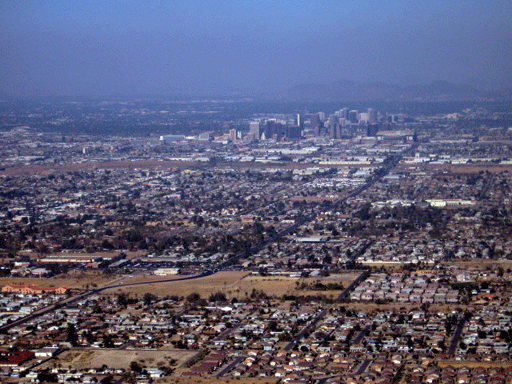|
|
||||
View from the Top
As I drove the winding roads to the top of South Mountain, I realized that the drive back might be more difficult. The lane coming down the mountain hugged the cliffs and crucial curves did not have a guard rail, but the view was magnificent. That view is the reason tourists and residents alike make the queasy trip to the top of the mountain. At the summit, you can stand on firm ground, lose that unsettled feeling and still get a spectacular panorama of most of the valley. I sat on a rock near the edge of a small cliff. The breeze was chilly and the sun was warm, a perfect combination. Two Latino couples sat on benches nearby with their arms wrapped around each other. There were families and couples standing on boulders, scrambling over rocks to get another view, and calling out to each other. I heard shouts and conversations in German and Spanish. Finally, I recognized an English speaking voice. A man was pointing out Central Avenue and Seventh Street to his female companion. Once the woman got her bearings, they exchanged sightings of the landmarks they recognized. The view is so wide, with no trees or buildings to obstruct the horizon. From this outlook, there are none of the divisions evident from the ground. The walls of gated communities are impossible to define. Eileen Moyer notes that the same type of fortified living space for the rich of Tanzania attracts rather than repels the poor (City and Society p.8) as the poor edge closer to render support services. If that is happening in South Phoenix, it is difficult to see from this point as well. Surely the gates must open to admit lawn keepers, pool maintenance workers, housekeepers, nannies. The east and west portions of the valley appear to be a harmonious blend that could not be easily divided. It is hard to tell where Laveen and South Phoenix meet each other, except that from this viewpoint the farm land in Laveen is vast compared to South Phoenix. I know from attending the Laveen Planning Committee meeting that Laveen does not want to “look” like South Phoenix. They do not want to lose their farm land to developers, expensive homes, and the “Architecture of Fear” described in Divided We Fall Gated and Walled Communities in the United States (Blakey, Snyder, 1997). These citizens have also seen what an irresistible force an innocuous phrase like “improvement and expansion” can be. The freeways that funnel that expansion are so all encompassing at street level, but they can barely be detected from these heights. Actually, nothing seems to really stand out except for the two tall clusters of high rise buildings that delineate downtown and uptown Phoenix. I know they are two separate groups of buildings because I live in Phoenix and use them as landmarks for navigating the city, just like South Mountain or Piestewa Peak or Camelback Mountain. From this perspective they look like one stand of omnipotent monuments to commerce, rulers of the rest of the valley. From this vantage point, I felt like I was the ruler of Phoenix. I watched helicopters linger below me and planes from Sky Harbor inch their way to a height greater than mine. I spotted groups of men playing golf at the base of the mountain. If I kept my gaze still, the movement of downtown trucks and cars came into view. There was so much motion down there. Not up here. At the top of South Mountain, it was quiet except for muffled voices, brisk and warm breezes at the same time and if I kept my vision on the horizon, no movement whatsoever. |
||||
|
||||

